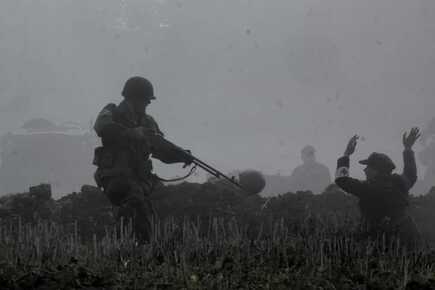
The German armed forces realised they needed help to run the administration forces in order to aid the defence of Germany.
As such they recruited aid from the German and Scandinavian women.
The Helferinnen became a valuable part of the war effort. They were important in relaying communications between the rear echelons and the front line.
As the lines diminished the Helferinnen would often find themselves caught up in the chaos of the front line.
The WW II German Sanitaters were responsible for the health & welfare of casualties from armed conflict.
Photographic evidence proves this often involved the treatment of those injured from the opposing side.
Despite being protected by the Geneva convention, medics were often the target of enemy fire, particularly on the Eastern front.
The German armed forces provided their own medical Doctors and orderlies, but were often assisted by members of the Deutsches Rotes Kreuz (DRK). This perilous role took many non-combatants dangerously close to the front line.
Norwegian Nurses (front sisters) often served in pairs and tended to those wounded at the frontline which endangered their lives. Approximately 350 to 400 also served exclusively alongside the Waffen SS.
Kampfgruppe Stahlkriegers Feldlazerett is efficiently stocked and run by several society members who maintain the values of those who served alongside the armed elements within the Leibstandarte.
As such they recruited aid from the German and Scandinavian women.
The Helferinnen became a valuable part of the war effort. They were important in relaying communications between the rear echelons and the front line.
As the lines diminished the Helferinnen would often find themselves caught up in the chaos of the front line.
The WW II German Sanitaters were responsible for the health & welfare of casualties from armed conflict.
Photographic evidence proves this often involved the treatment of those injured from the opposing side.
Despite being protected by the Geneva convention, medics were often the target of enemy fire, particularly on the Eastern front.
The German armed forces provided their own medical Doctors and orderlies, but were often assisted by members of the Deutsches Rotes Kreuz (DRK). This perilous role took many non-combatants dangerously close to the front line.
Norwegian Nurses (front sisters) often served in pairs and tended to those wounded at the frontline which endangered their lives. Approximately 350 to 400 also served exclusively alongside the Waffen SS.
Kampfgruppe Stahlkriegers Feldlazerett is efficiently stocked and run by several society members who maintain the values of those who served alongside the armed elements within the Leibstandarte.

